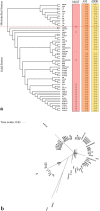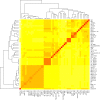Comparative genome analysis provides deep insights into Aeromonas hydrophila taxonomy and virulence-related factors
- PMID: 30257645
- PMCID: PMC6158803
- DOI: 10.1186/s12864-018-5100-4
Comparative genome analysis provides deep insights into Aeromonas hydrophila taxonomy and virulence-related factors
Abstract
Background: Aeromonas hydrophila is a potential zoonotic pathogen and primary fish pathogen. With overlapping characteristics, multiple isolates are often mislabelled and misclassified. Moreover, the potential pathogenic factors among the publicly available genomes in A. hydrophila strains of different origins have not yet been investigated.
Results: To identify the valid strains of A. hydrophila and their pathogenic factors, we performed a pan-genomic study. It revealed that there were 13 mislabelled strains and 49 valid strains that were further verified by Average nucleotide identity (ANI), digital DNA-DNA hybridization (dDDH) and in silico multiple locus strain typing (MLST). Multiple numbers of phages were detected among the strains and among them Aeromonas phi 018 was frequently present. The diversity in type III secretion system (T3SS) and conservation of type II and type VI secretion systems (T2SS and T6SS, respectively) among all the strains are important to study for designing future strategies. The most prevalent antibiotic resistances were found to be beta-lactamase, polymyxin and colistin resistances. The comparative analyses of sequence type (ST) 251 and other ST groups revealed that there were higher numbers of virulence factors in ST-251 than in other STs group.
Conclusion: Publicly available genomes have 13 mislabelled organisms, and there are only 49 valid A. hydrophila strains. This valid pan-genome identifies multiple prophages that can be further utilized. Different A. hydrophila strains harbour multiple virulence factors and antibiotic resistance genes. Identification of such factors is important for designing future treatment regimes.
Keywords: Aeromonas; Antibiotic resistance patterns; Mislabelled strains; Pan-genome; Prophages; Virulence factors.
Conflict of interest statement
Ethics approval and consent to participate
Not applicable.
Consent for publication
Not applicable.
Competing interests
The authors declare that they have no competing interests.
Publisher’s Note
Springer Nature remains neutral with regard to jurisdictional claims in published maps and institutional affiliations.
Figures












Similar articles
-
Novel insights into the pathogenicity of epidemic Aeromonas hydrophila ST251 clones from comparative genomics.Sci Rep. 2015 May 27;5:9833. doi: 10.1038/srep09833. Sci Rep. 2015. PMID: 26014286 Free PMC article.
-
Characterization of Aeromonas hydrophila wound pathotypes by comparative genomic and functional analyses of virulence genes.mBio. 2013 Apr 23;4(2):e00064-13. doi: 10.1128/mBio.00064-13. mBio. 2013. PMID: 23611906 Free PMC article.
-
Pan-genome analysis of Aeromonas hydrophila, Aeromonas veronii and Aeromonas caviae indicates phylogenomic diversity and greater pathogenic potential for Aeromonas hydrophila.Antonie Van Leeuwenhoek. 2016 Jul;109(7):945-56. doi: 10.1007/s10482-016-0693-6. Epub 2016 Apr 13. Antonie Van Leeuwenhoek. 2016. PMID: 27075453
-
Development of diagnostic and vaccine markers through cloning, expression, and regulation of putative virulence-protein-encoding genes of Aeromonas hydrophila.J Microbiol. 2013 Jun;51(3):275-82. doi: 10.1007/s12275-013-2437-x. Epub 2013 Jun 28. J Microbiol. 2013. PMID: 23812806 Review.
-
Virulence Factors of Aeromonas hydrophila: In the Wake of Reclassification.Front Microbiol. 2016 Aug 25;7:1337. doi: 10.3389/fmicb.2016.01337. eCollection 2016. Front Microbiol. 2016. PMID: 27610107 Free PMC article. Review.
Cited by
-
Identification of Antimicrobial Resistance Determinants in Aeromonas veronii Strain MS-17-88 Recovered From Channel Catfish (Ictalurus punctatus).Front Cell Infect Microbiol. 2020 Jul 17;10:348. doi: 10.3389/fcimb.2020.00348. eCollection 2020. Front Cell Infect Microbiol. 2020. PMID: 32766165 Free PMC article.
-
Genomic Characterization of Aeromonas veronii Provides Insights into Taxonomic Assignment and Reveals Widespread Virulence and Resistance Genes throughout the World.Antibiotics (Basel). 2023 Jun 11;12(6):1039. doi: 10.3390/antibiotics12061039. Antibiotics (Basel). 2023. PMID: 37370358 Free PMC article.
-
Whole spectrum of Aeromonas hydrophila virulence determinants and the identification of novel SNPs using comparative pathogenomics.Sci Rep. 2023 May 12;13(1):7712. doi: 10.1038/s41598-023-34887-1. Sci Rep. 2023. PMID: 37173388 Free PMC article.
-
Aeromonas dhakensis: A Zoonotic Bacterium of Increasing Importance in Aquaculture.Pathogens. 2024 May 31;13(6):465. doi: 10.3390/pathogens13060465. Pathogens. 2024. PMID: 38921763 Free PMC article. Review.
-
Reclassification of 11 Members of the Family Rhodobacteraceae at Genus and Species Levels and Proposal of Pseudogemmobacter hezensis sp. nov.Front Microbiol. 2022 Apr 13;13:849695. doi: 10.3389/fmicb.2022.849695. eCollection 2022. Front Microbiol. 2022. PMID: 35495672 Free PMC article.
References
-
- Stratev D, Vashin I, Rusev V. Prevalence and survival of Aeromonas spp. in foods - a review. Revue Med Vet. 2012;163:486–494.
Publication types
MeSH terms
Substances
Grants and funding
LinkOut - more resources
Full Text Sources
Other Literature Sources
Molecular Biology Databases

